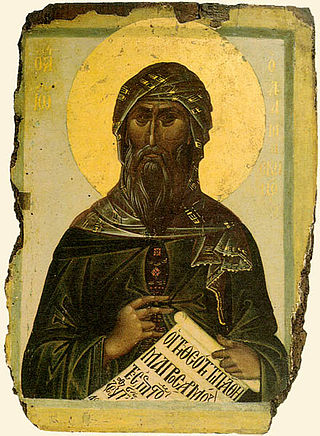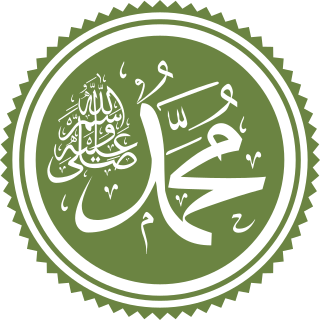Related Research Articles

Religion in pre-Islamic Arabia included indigenous Arabian polytheism, ancient Semitic religions, Christianity, Judaism, Mandaeism, and Iranian religions such as Zoroastrianism, and Manichaeism, and rarely Buddhism.

John of Damascus or John Damascene was a Christian monk, priest, hymnographer, and apologist. Born and raised in Damascus c. 675 or 676; the precise date and place of his death is not known, though tradition places it at his monastery, Mar Saba, near Jerusalem on 4 December 749.
Abu Ubaida, Obaida, or UbaydahMa’mar ibn ul-Muthanna-Abu al-Mukhtar Firas b. Khindif was an early Muslim scholar of Arabic philology. Abu Ubaida was a controversial figure; later scholar Ibn Qutaybah remarked that Abu Ubaida "hated Arabs," though his contemporaries still considered him perhaps the most well-rounded scholar of his age. Whether or not Abu Ubaida was truly a supporter of the Shu'ubiyya is a matter of debate.

The early Muslim conquests or early Islamic conquests, also referred to as the Arab conquests, were initiated in the 7th century by Muhammad, the main Islamic prophet. He established a new unified polity in Arabia that expanded rapidly under the Rashidun Caliphate and the Umayyad Caliphate, culminating in Islamic rule being established across three continents. According to Scottish historian James Buchan: "In speed and extent, the first Arab conquests were matched only by those of Alexander the Great, and they were more lasting."

Touraj Daryaee is an Iranian Iranologist and historian. He currently works as the Maseeh Chair in Persian Studies and Culture and the director of the Dr. Samuel M. Jordan Center for Persian Studies at the University of California, Irvine.
Hagarenes, is a term widely used by early Syriac, Greek, Coptic and Armenian sources to describe the early Arab conquerors of Mesopotamia, Syria and Egypt.

The Teaching of Jacob, has a controversial dating from the early 7th century to the late 8th century. A Greek Christian polemical tract supposedly set in Carthage in 634 but written in Palestine sometime between 634 and 640. It supposedly records a weeks-long discussion ending on July 13, 634, among Jews who have been forcibly baptized by order of the emperor. One of them, Jacob, has come to believe sincerely in Christianity; he instructs the rest about why they should also sincerely embrace their new faith. Halfway through, a Jewish merchant named Justus arrives and challenges Jacob to a debate. In the end, all of the participants are convinced to embrace Christianity, and Jacob and Justus return east. In addition to several partial Greek manuscripts, the text survives in Latin, Arabic, Ethiopic and Slavonic translations.
The Battle of Dathin was a battle during the Arab–Byzantine Wars between the Rashidun Caliphate and the Byzantine Empire in February 634, but became very famous in the literature of the period.
Life of Gabriel of Qartmin is a Syriac 8th-century manuscript containing the life of Gabriel of Beth Qustan, Bishop of Tur Abdin, which helps to provides a glimpse into the events in the Middle East during the 7th century.

Seeing Islam As Others Saw It: A Survey and Evaluation of Christian, Jewish and Zoroastrian Writings on Early Islam from the Studies in Late Antiquity and Early Islam series is a book by scholar of the Middle East Robert G. Hoyland.
Thomas the Presbyter was a Syriac Orthodox priest from the vicinity of Reshaina in Upper Mesopotamia who wrote the Syriac Chronicle of 640, which is also known by many other names.

The historicity of Muhammad refers to the study of Muhammad as a historical figure and critical examination of sources upon which traditional accounts are based.
The spread of Islam spans about 1,400 years. Muslim conquests following Muhammad's death led to the creation of the caliphates, occupying a vast geographical area; conversion to Islam was boosted by Arab Muslim forces conquering vast territories and building imperial structures over time. Most of the significant expansion occurred during the reign of the Rashidun from 632 to 661 CE, which was the reign of the first four successors of Muhammad. These early caliphates, coupled with Muslim economics and trading, the Islamic Golden Age, and the age of the Islamic gunpowder empires, resulted in Islam's spread outwards from Mecca towards the Indian, Atlantic, and Pacific Oceans and the creation of the Muslim world. Trade played an important role in the spread of Islam in several parts of the world, especially Indian traders in Southeast Asia.
The Revisionist school of Islamic studies, is a movement in Islamic studies that questions traditional Muslim narratives of Islam's origins.
The Chronicle of Khuzestan is an anonymous 7th-century Nestorian Christian chronicle. Written in Syriac, it covers the period from the reign of the Sasanian ruler Hormizd IV to the fall of the Sasanian Empire (652). The chronicle was discovered by the Italian orientalist Ignazio Guidi (1844–1935), hence it is also known as Guidi's Chronicle or the Guidi Anonymous. It is thought by some to be a portion of a lost history written by Elias of Merv. It is an important source for the early Muslim conquests.

Elias of Heliopolis (759–779), also called Elias of Damascus, was a Syrian carpenter and Christian martyr revered as a saint in the Eastern Orthodox and Syriac Orthodox churches. He is known from a Greek hagiography.
Simeon of Rev Ardashir, whose name in Syriac is Shemʿon, was a Persian priest and jurist of the Church of the East. He served as the metropolitan bishop of Fars with his seat at Rev Ardashir. His dates are uncertain, as is his identification with the metropolitan of the same name known from a pair of letters.
Daniel bar Maryam was a historian and chronographer of the Church of the East who lived in the 7th century.

Tultusceptru de libro domni Metobii is a short Latin biography of Muḥammad written in the 9th or 10th century in the Iberian Peninsula. It is a polemical text designed to show that Islam is a false religion and Muḥammad the unwitting dupe of the devil. It is known from a single copy in the Codex of Roda. Although the codex was compiled in the late 10th century, the Tultusceptru was added between about 1030 and 1060.
References
- ↑ "Institute for the Study of the Ancient World, New York University" . Retrieved 21 January 2015.
- ↑ "Faculty of Oriental Studies, University of Oxford". Archived from the original on 7 July 2011. Retrieved 27 May 2011.
- ↑ Hoyland, Robert G. (1997). Seeing Islam as others saw it: A survey and evaluation of Christian, Jewish, and Zoroastrian writings on early Islam. Princeton, NJ: Darwin Press. ISBN 0-87850-125-8 . Retrieved 27 May 2011.
- ↑ Dr Youssef Choueiri, Review of In God’s Path Reviews in History No. 1780